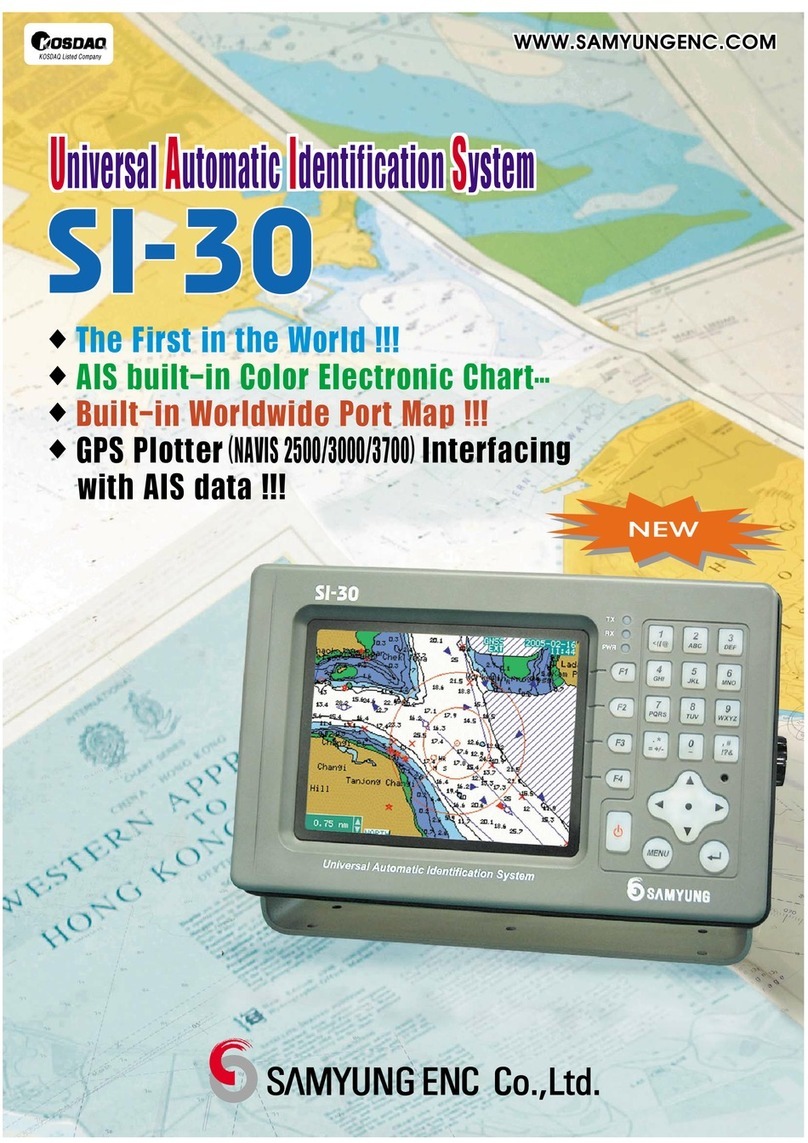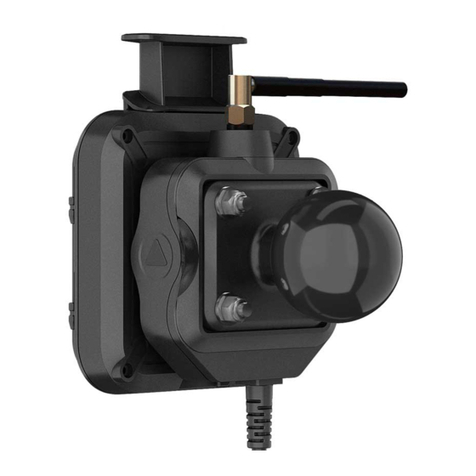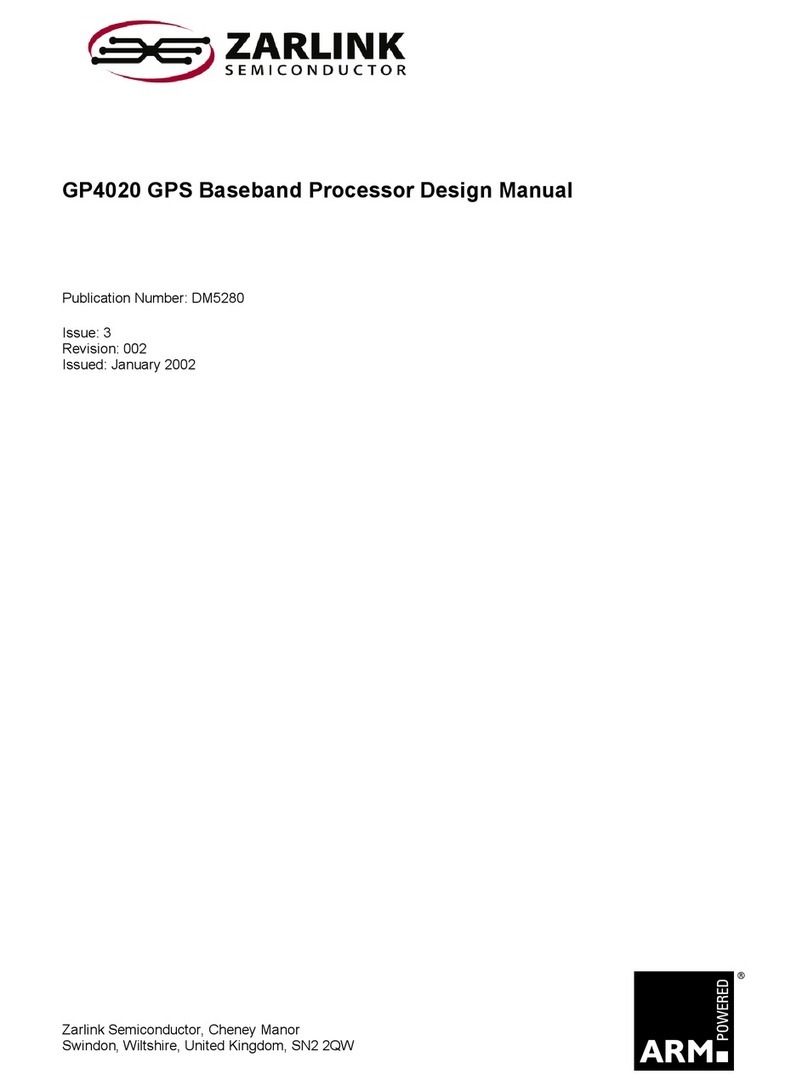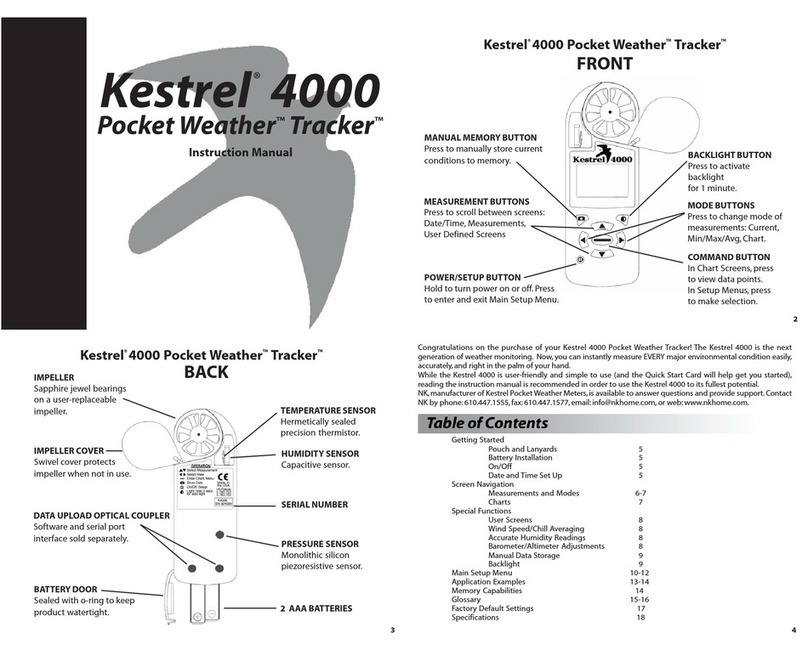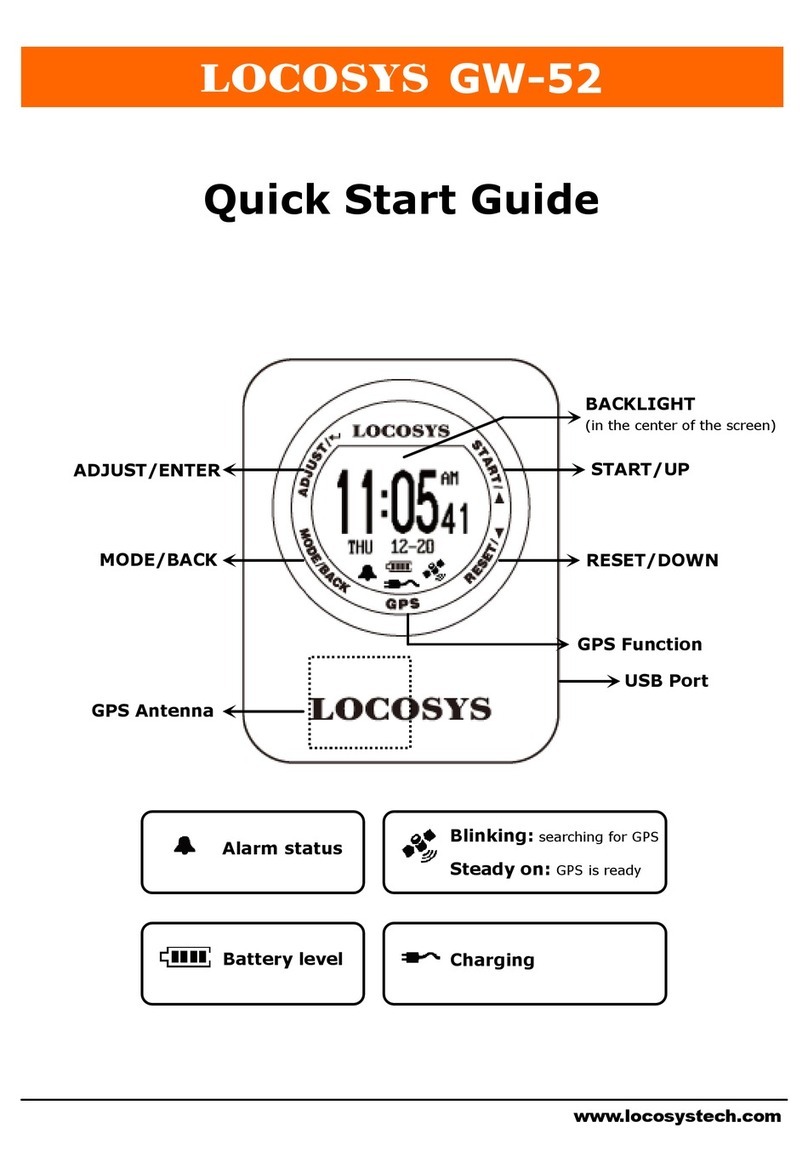Linx Technologies RM Series Instruction Manual

RM Series
GPS Receiver Module
Data Guide

Table of Contents
1 Description
1 Features
1 Applications Include
2 Ordering Information
2 Absolute Maximum Ratings
2 ElectricalSpecications
4 Pin Assignments
4 Pin Descriptions
5 A Brief Overview of GPS
6 Time To First Fix (TTFF)
6 Module Description
7 Backup Battery
7 Power Supply Requirements
8 The 1PPS Output
8 Power Control
9 Antenna Considerations
10 Slow Start Time
11 Interfacing with NMEA Messages
12 NMEA Output Messages
19 Input Messages
31 Typical Applications
32 Master Development System
33 Microstrip Details
34 Board Layout Guidelines
35 Pad Layout
36 Production Guidelines
36 Hand Assembly
36 Automated Assembly
38 Appendix A
Warning: Some customers may want Linx radio frequency (“RF”)
products to control machinery or devices remotely, including machinery
or devices that can cause death, bodily injuries, and/or property
damage if improperly or inadvertently triggered, particularly in industrial
settings or other applications implicating life-safety concerns (“Life and
Property Safety Situations”).
NO OEM LINX REMOTE CONTROL OR FUNCTION MODULE
SHOULD EVER BE USED IN LIFE AND PROPERTY SAFETY
SITUATIONS. No OEM Linx Remote Control or Function Module
should be modified for Life and Property Safety Situations. Such
modification cannot provide sufficient safety and will void the product’s
regulatory certification and warranty.
Customers may use our (non-Function) Modules, Antenna and
Connectors as part of other systems in Life Safety Situations, but
only with necessary and industry appropriate redundancies and
in compliance with applicable safety standards, including without
limitation, ANSI and NFPA standards. It is solely the responsibility
of any Linx customer who uses one or more of these products to
incorporate appropriate redundancies and safety standards for the Life
and Property Safety Situation application.
Do not use this or any Linx product to trigger an action directly
from the data line or RSSI lines without a protocol or encoder/
decoder to validate the data. Without validation, any signal from
another unrelated transmitter in the environment received by the module
could inadvertently trigger the action.
All RF products are susceptible to RF interference that can prevent
communication. RF products without frequency agility or hopping
implemented are more subject to interference. This module does not
have a frequency hopping protocol built in.
Do not use any Linx product over the limits in this data guide.
Excessive voltage or extended operation at the maximum voltage could
cause product failure. Exceeding the reflow temperature profile could
cause product failure which is not immediately evident.
Do not make any physical or electrical modifications to any Linx
product. This will void the warranty and regulatory and UL certifications
and may cause product failure which is not immediately evident.
!

– –
1
Description
The RM Series GPS receiver module is a
self-contained high-performance Global
Positioning System receiver. Based on
the MediaTek MT3337E chipset, it can
simultaneously acquire on 66 channels and
track on up to 22 channels. This gives the
module fast lock times and high position
accuracy even at low signal levels.
The module’s exceptional sensitivity gives it
superior performance, even in dense foliage and urban canyons. Its very
low power consumption helps maximize runtimes in battery powered
applications. The module outputs standard NMEA data messages through
a UART interface.
Housed in a compact reflow-compatible SMD package, the receiver
requires no programming or additional RF components (except an antenna)
to form a complete GPS solution. This makes the RM Series easy to
integrate, even by engineers without previous RF or GPS experience.
Features
• MediaTek chipset
• High sensitivity (–161dBm)
• Fast TTFF at low signal levels
• ±11ns 1PPS accuracy
• Battery-backed SRAM
• No programming necessary
• No external RF components
needed (except an antenna)
• No production tuning
• UART serial interface
• Power control features
• Compact SMD package
Applications Include
• Positioning and Navigation
• Location and Tracking
• Security/Loss-Prevention
• Surveying
• Logistics
• Fleet Management
RM Series GPS Receiver
Data Guide
Revised 10/6/2016
RXM-GPS-RM
LOT GRxxxx
0.591 in
(15.00 mm)
0.512 in
(13.00 mm)
0.087 in
(2.20 mm)
Figure 1: Package Dimensions
46 Resources
47 Notes
Warning: This product incorporates numerous static-sensitive
components. Always wear an ESD wrist strap and observe proper ESD
handling procedures when working with this device. Failure to observe
this precaution may result in module damage or failure.

– – – –
2 3
Ordering Information
Ordering Information
Part Number Description
RXM-GPS-RM-x RM Series GPS Receiver Module
MDEV-GPS-RM RM Series GPS Receiver Master Development System
EVM-GPS-RM RM Series Evaluation Module
x = “T” for Tape and Reel, “B” for Bulk
Reels are 1,000 pieces. Quantities less than 1,000 pieces are supplied in bulk
Absolute Maximum Ratings
Supply Voltage VCC +4.3 VDC
Input Battery Backup Voltage +4.3 VDC
VCC_RF Output Current 50 mA
Operating Temperature −40 to +85 ºC
Storage Temperature −40 to +85 ºC
Exceeding any of the limits of this section may lead to permanent damage to the device.
Furthermore, extended operation at these maximum ratings may reduce the life of this
device.
Absolute Maximum Ratings
RM Series GPS Receiver Specifications
Parameter Symbol Min. Typ. Max. Units Notes
Power Supply
Operating Voltage VCC 3.0 3.3 4.3 VDC
Supply Current lCC
Peak 44 mA 1
Acquisition 14 mA 1
Tracking 12 mA 1
Standby 0.135 mA 1
Backup Battery Voltage VBAT 2.0 4.3 VDC
Backup Battery Current IBAT 6 µA 2
ElectricalSpecications
RM Series GPS Receiver Specifications
Parameter Symbol Min. Typ. Max. Units Notes
VOUT Output Voltage VOUT 2.7 2.8 2.9 VDC
VOUT Output Current IOUT 30 mA 1
Output Low Voltage VOL 0.4 VDC
Output High Voltage VOH 2.4 VCC
Output Low Current IOL 2.0 mA
Output High Current IOH 2.0 mA
Input Low Voltage VIL –0.3 0.8 VDC
Input High Voltage VIH 2.0 3.6 VDC
Input Low Current IIL –1 1 µA 3
Input High Current IIH –1 1 µA 3
Minimum RESET Pulse TRST 1 ms
Antenna Port
RF Impedance RIN 50 Ω
Receiver Section
Receiver Sensitivity
Tracking –161 dBm
Cold Start –143 dBm
Acquisition Time
Hot Start (Open Sky) 1 s
Hot Start (Indoor) 30 s
Cold Start 32 s
Cold Start, AGPS 15 s
Position Accuracy
Autonomous 3 m
1PPS Accuracy -11 11 ns 4
Altitude 50,000 m
Velocity 515 m/s
Chipset MediaTek MT3337E
Frequency L1 1575.42MHz, C/A code
Channels 22 tracking, 66 acquisition
Update Rate 1Hz default, up to 10Hz
Protocol Support NMEA 0183 ver 3.01
1. VCC = 3.3V, without active antenna, position fix is available
2. VCC = 0V
3. No pull-up or pull-down on the lines
4. Relative to other RM Series modules, not to UTC time
Figure 2: Ordering Information
Figure 3: Absolute Maximum Ratings
Figure 4: Electrical Specifications

– – – –
4 5
NC1
NC2
1PPS3
TX4
RX5
GND21
NC6
LCKIND7
RESET8
NC9
NC10
GND 20
RFIN 19
GND 18
VOUT 17
NC 16
GND 22
NC 15
NC 14
NC 13
VCC 12
VBACKUP 11
Pin Assignments
Pin Descriptions
Pin Descriptions
Pin Number Name I/O Description
1, 2, 6, 9, 10,
13, 14, 15, 16 NC − No electrical connection
3 1PPS O 1 Pulse Per Second
4 TX O Serial output (default NMEA)
5 RX I Serial input (default NMEA)
7 LCKIND O Lock Indicator. Outputs a 100ms pulse every
second when a GPS fix is available.
8 RESET I Active low module reset. This line is pulled high
internally. Leave it unconnected if it is not used.
11 VBACKUP P Backup battery supply voltage. This line must be
powered to enable the module.
12 VCC P Supply Voltage
17 VOUT O 2.8V output for an active antenna
18, 20, 21, 22 GND P Ground
19 RFIN I GPS RF signal input
Figure 5: RM Series GPS Receiver Pinout (Top View)
Figure 6: RM Series GPS Receiver Pin Descriptions
A Brief Overview of GPS
The Global Positioning System (GPS) is a U.S.-owned utility that freely and
continuously provides positioning, navigation, and timing (PNT) information.
Originally created by the U.S. Department of Defense for military
applications, the system was made available without charge to civilians
in the early 1980s. The global positioning system consists of a nominal
constellation of 24 satellites orbiting the earth at about 12,000 nautical
miles in height. The pattern and spacing of the satellites allow at least four
to be visible above the horizon from any point on the Earth. Each satellite
transmits low power radio signals which contain three different bits of
information; a pseudorandom code identifying the satellite, ephemeris data
which contains the current date and time as well as the satellite’s health,
and the almanac data which tells where each satellite should be at any time
throughout the day.
A GPS receiver receives and times the signals sent by multiple satellites
and calculates the distance to each satellite. If the position of each satellite
is known, the receiver can use triangulation to determine its position
anywhere on the earth. The receiver uses four satellites to solve for four
unknowns; latitude, longitude, altitude and time. If any of these factors is
already known to the system, an accurate position (fix) can be obtained
with fewer satellites in view. Tracking more satellites improves calculation
accuracy. In essence, the GPS system provides a unique address for every
square meter on the planet.
A faster Time To First Fix (TTFF) is also possible if the satellite information
is already stored in the receiver. If the receiver knows some of this
information, then it can accurately predict its position before acquiring an
updated position fix. For example, aircraft or marine navigation equipment
may have other means of determining altitude, so the GPS receiver would
only have to lock on to three satellites and calculate three equations to
provide the first position fix after power-up.

– – – –
6 7
Time To First Fix (TTFF)
TTFF is often broken down into three parts.
Cold: A cold start is when the receiver has no accurate knowledge of its
position or time. This happens when the receiver’s internal Real Time Clock
(RTC) has not been running or it has no valid ephemeris or almanac data.
In a cold start, the receiver takes up to 30 seconds to acquire its position.
Warm: A typical warm start is when the receiver has valid almanac and time
data and has not significantly moved since its last valid position calculation.
This happens when the receiver has been shut down for more than 2
hours, but still has its last position, time, and almanac saved in memory,
and its RTC has been running. The receiver can predict the location of the
current visible satellites and its location; however, it needs to wait for an
ephemeris broadcast (every 30 seconds) before it can accurately calculate
its position.
Hot: A hot start is when the receiver has valid ephemeris, time, and
almanac data. In a hot start, the receiver takes 1 second to acquire its
position. The time to calculate a fix in this state is sometimes referred to as
Time to Subsequent Fix or TTSF.
Module Description
The RM Series GPS Receiver module is based on the MediaTek MT3337E
chipset, which consumes less power than competitive products while
providing exceptional performance even in dense foliage and urban
canyons. No external RF components are needed other than an antenna.
The simple serial interface and industry standard NMEA protocol make
integration of the RM Series into an end product extremely straightforward.
The module’s high-performance RF architecture allows it to receive GPS
signals that are as low as –161dBm. The RM Series can track up to 22
satellites at the same time. Once locked onto the visible satellites, the
receiver calculates the range to the satellites and determines its position
and the precise time. It then outputs the data through a standard serial port
using several standard NMEA protocol formats.
The GPS core handles all of the necessary initialization, tracking, and
calculations autonomously, so no programming is required. The RF section
is optimized for low level signals, and requires no production tuning.
Backup Battery
The module is designed to work with a backup battery that keeps the
SRAM memory and the RTC powered when the RF section and the main
GPS core are powered down. This enables the module to have a faster
Time To First Fix (TTFF) when it is powered back on. The memory and
clock pull about 6µA. This means that a small lithium battery is sufficient to
power these sections. This significantly reduces the power consumption
and extends the main battery life while allowing for fast position fixes when
the module is powered back on.
The backup battery must be installed for the module to be enabled.
Power Supply Requirements
The module requires a clean, well-regulated power source. While it is
preferable to power the unit from a battery, it can operate from a power
supply as long as noise is less than 20mV. Power supply noise can
significantly affect the receiver’s sensitivity, therefore providing clean power
to the module should be a high priority during design.
Bypass capacitors should be placed as close as possible to the module.
The values should be adjusted depending on the amount and type of noise
present on the supply line.
Figure 7: Supply Filter
NC
1
NC
2
1PPS
3
TX
4
RX
5
GND
21
NC
6
LCKIND
7
8
NC
9
NC
10
GND 20
RFIN 19
GND 18
VOUT 17
NC 16
GND 22
NC 15
NC 14
NC 13
VCC 12
VBACKUP 11
VCC
GND
RESET

– – – –
8 9
Antenna Considerations
The RM Series module is designed to utilize a wide variety of external
antennas. The module has a regulated power output which simplifies
the use of GPS antenna styles which require external power. This allows
the designer great flexibility, but care must be taken in antenna selection
to ensure optimum performance. For example, a handheld device may
be used in many varying orientations so an antenna element with a wide
and uniform pattern may yield better overall performance than an antenna
element with high gain and a correspondingly narrower beam. Conversely,
an antenna mounted in a fixed and predictable manner may benefit from
pattern and gain characteristics suited to that application. Evaluating
multiple antenna solutions in real-world situations is a good way to rapidly
assess which will best meet the needs of your application.
For GPS, the antenna should have good right hand circular polarization
characteristics (RHCP) to match the polarization of the GPS signals.
Ceramic patches are the most commonly used style of antenna, but
there are many different shapes, sizes and styles of antennas available.
Regardless of the construction, they will generally be either passive or
active types. Passive antennas are simply an antenna tuned to the correct
frequency. Active antennas add a Low Noise Amplifier (LNA) after the
antenna and before the module to amplify the weak GPS satellite signals.
For active antennas, a 300 ohm ferrite bead can be used to connect the
VOUT line to the RFIN line. This bead prevents the RF from getting into the
power supply, but allows the DC voltage onto the RF trace to feed into the
antenna. A series capacitor inside the module prevents this DC voltage
from affecting the bias on the module’s internal LNA.
Maintaining a 50 ohm path between the module and antenna is critical.
Errors in layout can significantly impact the module’s performance. Please
review the layout guidelines section carefully to become more familiar with
these considerations.
The 1PPS Output
The 1PPS line outputs 1 pulse per second on the rising edge of the GPS
second when the receiver has an over-solved navigation solution from five
or more satellites. The pulse has a duration of 100ms by default with the
rising edge on the GPS second. This line is low until the receiver acquires a
3D fix. The pulse width can be adjusted with a serial command.
The GPS second is based on the atomic clocks in the satellites, which are
monitored and set to Universal Time master clocks. This output and the
time calculated from the satellite transmissions can be used as a clock
feature in an end product. It has a ±11ns accuracy relative to other RM
Series GPS receiver modules.
Power Control
The RM Series GPS Receiver module offers several ways to control the
module’s power. A serial command puts the module into a low-power
standby mode that consumes only 135µA of current. An external processor
can be used to power the module on and off to conserve battery power.
Standby mode is configured by command 161.
Note: The receiver duty cycle mode was removed from modules with
date code 1612 and later.

– – – –
10 11
Slow Start Time
The most critical factors in start time are current ephemeris data, signal
strength and sky view. The ephemeris data describes the path of each
satellite as they orbit the earth. This is used to calculate the position of
a satellite at a particular time. This data is only usable for a short period
of time, so if it has been more than a few hours since the last fix or if the
location has significantly changed (a few hundred miles), then the receiver
may need to wait for a new ephemeris transmission before a position can
be calculated. The GPS satellites transmit the ephemeris data every 30
seconds. Transmissions with a low signal strength may not be received
correctly or be corrupted by ambient noise. The view of the sky is important
because the more satellites the receiver can see, the faster the fix and the
more accurate the position will be when the fix is obtained.
If the receiver is in a very poor location, such as inside a building, urban
canyon, or dense foliage, then the time to first fix can be slowed. In very
poor locations with poor signal strength and a limited view of the sky with
outdated ephemeris data, this could be on the order of several minutes.
In the worst cases, the receiver may need to receive almanac data, which
describes the health and course data for every satellite in the constellation.
This data is transmitted every 15 minutes. If a lock is taking a long time, try
to find a location with a better view of the sky and fewer obstructions. Once
locked, it is easier for the receiver to maintain the position fix.
Interfacing with NMEA Messages
Linx modules default to the NMEA protocol. Output messages are sent
from the receiver on the TX line and input messages are sent to the receiver
on the RX line. By default, output messages are sent once every second.
Details of each message are described in the following sections.
The NMEA message format is as follows: <Message-ID + Data Payload +
Checksum + End Sequence>. The serial data structure defaults to
9,600bps, 8 data bits, 1 start bit, 1 stop bit, and no parity. Each message
starts with a $ character and ends with a <CR> <LF>. All fields within
each message are separated by a comma. The checksum follows the *
character and is the last two characters, not including the <CR> <LF>.
It consists of two hex digits representing the exclusive OR (XOR) of all
characters between, but not including, the $ and * characters. When
reading NMEA output messages, if a field has no value assigned to it, the
comma will still be placed following the previous comma. For example,
{,04,,,,,2.0,} shows four empty fields between values 04 and 2.0. When
writing NMEA input messages, all fields are required, none are optional. An
empty field will invalidate the message and it will be ignored.
Reading NMEA output messages:
• Initialize a serial interface to match the serial data structure of the GPS
receiver.
• Read the NMEA data from the TX pin into a receive buffer.
• Separate it into six buffers, one for each message type. Use the
characters ($) and <CR> <LF> as end points for each message.
• For each message, calculate the checksum as mentioned above to
compare with the received checksum.
• Parse the data from each message using commas as field separators.
• Update the application with the parsed field values.
• Clear the receive buffer and be ready for the next set of messages.
Writing NMEA input messages:
• Initialize a serial interface to match the serial data structure of the GPS
receiver.
• Assemble the message to be sent with the calculated checksum.
• Transmit the message to the receiver on the RX line.

– – – –
12 13
NMEA Output Messages
The following sections outline the data structures of the various NMEA
messages that are supported by the module. By default, the NMEA
commands are output at 9,600bps, 8 data bits, 1 start bit, 1 stop bit, and
no parity.
Six messages are output at a 1Hz rate by default. The ZDA message is
supported, but disabled by default. These messages are shown in Figure 8.
Details of each message and examples are given in the following sections.
NMEA Output Messages
Name Description
GGA Contains the essential fix data which provide location and accuracy
GLL Contains just position and time
GSA Contains data on the Dilution of Precision (DOP) and which satellites are used
GSV
Contains the satellite location relative to the receiver and its signal to noise
ratio. Each message can describe 4 satellites so multiple messages may be
output depending on the number of satellites being tracked.
RMC Contains the minimum data of time, position, speed and course
VTG Contains the course and speed over the ground
ZDA Contains the date and time
Figure 8: NMEA Output Messages
GGA – Global Positioning System Fix Data
Figure 9 contains the values for the following example:
$GPGGA,053740.000,2503.6319,N,12136.0099,E,1,08,1.1,63.8,M,15.2,M,,0000*64
Global Positioning System Fix Data Example
Name Example Units Description
Message ID $GPGGA GGA protocol header
UTC Time 053740.000 hhmmss.sss
Latitude 2503.6319 ddmm.mmmm
N/S Indicator N N=north or S=south
Longitude 12136.0099 dddmm.mmmm
E/W Indicator E E=east or W=west
Position Fix Indicator 1 See Figure 10
Satellites Used 08 Range 0 to 33
HDOP 1.1 Horizontal Dilution of Precision
MSL Altitude 63.8 meters
Units M meters
Geoid Separation 15.2 meters
Units M meters
Age of Diff. Corr. second Null fields when DGPS is not used
Diff. Ref. Station 0000
Checksum *64
<CR> <LF> End of message termination
Position Indicator Values
Value Description
0 Fix not available or invalid
1 GPS SPS Mode, fix valid
2–5 Not supported
6 Dead Reckoning Mode, fix valid (requires external hardware)
Figure 9: Global Positioning System Fix Data Example
Figure 10: Position Indicator Values
Note: The GLL and VTG messages are enabled by default on modules
with date code 1612 and later. They were disabled by default on earlier
modules.

– – – –
14 15
GLL – Geographic Position – Latitude / Longitude
Figure 11 contains the values for the following example:
$GPGLL,2503.6319,N,12136.0099,E,053740.000,A,A*52
GSA – GPS DOP and Active Satellites
Figure 12 contains the values for the following example:
$GPGSA,A,3,24,07,17,11,28,08,20,04,,,,,2.0,1.1,1.7*35
GPS DOP and Active Satellites Example
Name Example Units Description
Message ID $GPGSA GSA protocol header
Mode 1 A See Figure 13
Mode 2 3 1=No fix, 2=2D, 3=3D
ID of satellite used 24 Sv on Channel 1
ID of satellite used 07 Sv on Channel 2
... ...
ID of satellite used Sv on Channel N
PDOP 2.0 Position Dilution of Precision
HDOP 1.1 Horizontal Dilution of Precision
VDOP 1.7 Vertical Dilution of Precision
Checksum *35
<CR> <LF> End of message termination
Geographic Position – Latitude / Longitude Example
Name Example Units Description
Message ID $GPGLL GLL protocol header
Latitude 2503.6319 ddmm.mmmm
N/S Indicator N N=north or S=south
Longitude 12136.0099 dddmm.mmmm
E/W Indicator E E=east or W=west
UTC Time 053740.000 hhmmss.sss
Status A A=data valid or V=data not valid
Mode A A=autonomous, N=Data not valid,
R=Coarse Position, S=Simulator
Checksum *52
<CR> <LF> End of message termination
Figure 11: Geographic Position – Latitude / Longitude Example
Figure 12: GPS DOP and Active Satellites Example
GSV – GPS Satellites in View
Figure 14 contains the values for the following example:
$GPGSV,3,1,12,28,81,285,42,24,67,302,46,31,54,354,,20,51,077,46*73
$GPGSV,3,2,12,17,41,328,45,07,32,315,45,04,31,250,40,11,25,046,41*75
$GPGSV,3,3,12,08,22,214,38,27,08,190,16,19,05,092,33,23,04,127,*7B
Mode 1 Values
Value Description
M Manual – forced to operate in 2D or 3D mode
A Automatic – allowed to automatically switch 2D/3D
GPS Satellites in View Example
Name Example Units Description
Message ID $GPGSV GSV protocol header
Total number of
messages13 Range 1 to 4
Message number11 Range 1 to 4
Satellites in view 12
Satellite ID 28 Channel 1 (Range 01 to 196)
Elevation 81 degrees Channel 1 (Range 00 to 90)
Azimuth 285 degrees Channel 1 (Range 000 to 359)
SNR (C/No) 42 dB–Hz Channel 1 (Range 00 to 99, null when not
tracking)
Satellite ID 20 Channel 2 (Range 01 to 196)
Elevation 51 degrees Channel 2 (Range 00 to 90)
Azimuth 077 degrees Channel 2 (Range 000 to 359)
SNR (C/No) 46 dB-Hz Channel 2 (Range 00 to 99, null when not
tracking.
Checksum *73
<CR> <LF> End of message termination
1. Depending on the number of satellites tracked, multiple messages of GSV data
may be required.
Figure 13: Mode 1 Values
Figure 14: GPS Satellites in View Example

– – – –
16 17
RMC – Recommended Minimum Specific GPS Data
Figure 15 contains the values for the following example:
$GPRMC,053740.000,A,2503.6319,N,12136.0099,E,2.69,79.65,100106,,,A*53
Recommended Minimum Specific GPS Data Example
Name Example Units Description
Message ID $GPRMC RMC protocol header
UTC Time 053740.000 hhmmss.sss
Status A A=data valid or V=data not valid
Latitude 2503.6319 ddmm.mmmm
N/S Indicator N N=north or S=south
Longitude 12136.0099 dddmm.mmmm
E/W Indicator E E=east or W=west
Speed over ground 2.69 knots TRUE
Course over ground 79.65 degrees
Date 100106 ddmmyy
Magnetic Variation degrees Not available, null field
Variation Sense E=east or W=west (not shown)
Mode A A=autonomous, E=DR, N= Data not
valid, R=Coarse Position, S=Simulator
Checksum *53
<CR> <LF> End of message termination
Figure 15: Recommended Minimum Specific GPS Data Example
VTG – Course Over Ground and Ground Speed
Figure 16 contains the values for the following example:
$GPVTG,79.65,T,,M,2.69,N,5.0,K,A*38
Course Over Ground and Ground Speed Example
Name Example Units Description
Message ID $GPVTG VTG protocol header
Course over ground 79.65 degrees Measured heading
Reference T TRUE
Course over ground degrees Measured heading (N/A, null field)
Reference M Magnetic
Speed over ground 2.69 knots Measured speed
Units N Knots
Speed over ground 5.0 km/hr Measured speed
Units K Kilometer per hour
Mode A A=autonomous, N= Data not valid,
R=Coarse Position, S=Simulator
Checksum *38
<CR> <LF> End of message termination
Figure 16: Course Over Ground and Ground Speed Example

– – – –
18 19
ZDA – Universal Time and Date
Figure 17 contains the values for the following example:
$GPZDA,183746.000,22,08,2014,,*56
Start-up Response
The module outputs a message when it starts up to indicate its state. The
normal start-up message is shown below and the message formatting is
shown in Figure 18.
$PMTK010,001*2E<CR><LF>
Start-up Response Example
Name Example Description
Message ID $PMTK010 Message header
Message
MSG
System Message
0 = Unknown
1 = Start-up
2 = Notification for the host supporting EPO
3 = Transition to Normal operation is successful
Checksum CKSUM
End Sequence <CR> <LF> End of message termination
Universal Time and Date Example
Name Example Units Description
Message ID $GPZDA ZDA protocol header
UTC Time 183746.000 hhmmss.sss
Day 22 01 to 31
Month 08 01 to 12
Year 2014 1980 to 2079
Local Zone Hour Offset from UTC; set to null
Local Zone Minutes Offset from UTC; set to null
Checksum *56
<CR> <LF> End of message termination
Figure 17: Universal Time and Date Example
Figure 18: Start-up Response Example
Input Messages
The following outlines the serial commands input into the module for
configuration. There are 3 types of input messages: commands, writes and
reads. The module outputs a response for each input message.
The commands are used to change the operating state of the module.
The writes are used to change the module’s configuration and the reads
are used to read out the current configuration. Messages are formatted as
shown in Figure 19. All fields in each message are separated by a comma.
Figure 20 shows the input commands.
Serial Data Structure
Name Example Description
Start Sequence $PMTK
Message ID <MID> Message Identifier consisting of three numeric
characters.
Payload DATA Message specific data.
Checksum CKSUM
CKSUM is a two-hex character checksum as
defined in the NMEA specification, NMEA-0183
Standard for Interfacing Marine Electronic Devices.
Checksums are required on all input messages.
End Sequence <CR> <LF>
Each message must be terminated using Carriage
Return (CR) Line Feed (LF) (\r\n, 0x0D0A) to cause
the receiver to process the input message. They
are not printable ASCII characters, so are omitted
from the examples.
Figure 19: Serial Data Structure
Input Commands
Name Description
101 Hot Re-start
102 Warm Re-start
103 Cold Re-start
104 Restore Default Configuration
161 Standby Mode
220 Position Fix Interval
251 Serial Port Baud Rate
255 Sync 1PPS and NMEA Messages
285 1PPS Configuration
286 Enable Active Interference Cancellation
Figure 20: Input Commands

– – – –
20 21
The write and read messages are shown in Figure 21. A write message
triggers an acknowledgement from the module. A read message triggers a
response message containing the requested information.
The module responds to commands with response messages. The
acknowledge message is formatted as shown in Figure 22.
Figure 21: Input Write and Read Messages
Input Write and Read Messages
Description Write ID Read ID Response ID
Set NMEA Output Messages 314 414 514
Set Datum 330 430 530
Static Navigation Threshold 386 447 527
Enable Ephemeris Prediction 869 869 869
Acknowledge Message
Name Example Description
Start Sequence $PMTK
Message ID 001 Acknowledge Identifier
Command CMD The command that triggered the acknowledge
Flag Flg
Flag indicating the outcome of the command
0 = Invalid Command
1 = Unsupported Command
2 = Valid command, but action failed
3 = Valid command and action succeeded
Checksum CKSUM
CKSUM is a two-hex character checksum as
defined in the NMEA specification, NMEA-0183
Standard for Interfacing Marine Electronic Devices.
Checksums are required on all input messages.
End Sequence <CR> <LF>
Each message must be terminated using Carriage
Return (CR) Line Feed (LF) (\r\n, 0x0D0A) to cause
the receiver to process the input message. They
are not printable ASCII characters, so are omitted
from the examples.
Figure 22: Acknowledge Message
101 – Hot Re-start
This command instructs the module to conduct a hot re-start using all of
the data stored in memory. Periodic mode and static navigation settings are
returned to default when this command is executed.
$PMTK101*32<CR><LF>
102 – Warm Re-start
This command instructs the module to conduct a warm re-start that does
not use the saved ephemeris data. Periodic mode and static navigation
settings are returned to default when this command is executed.
$PMTK102*31<CR><LF>
103 – Cold Re-start
This command instructs the module to conduct a cold re-start that does
not use any of the data from memory. Periodic mode and static navigation
settings are returned to default when this command is executed.
$PMTK103*30<CR><LF>
104 – Restore Default Configuration
This command instructs the module to conduct a cold re-start and return
all configurations to the factory default settings.
$PMTK104*37<CR><LF>
161 – Standby Mode
This command instructs the module to enter a low power standby mode.
Any activity on the RX line wakes the module. Only enter standby mode
after the module acquires a position fix.
$PMTK161,0*28<CR><LF>
The module outputs the startup message when it wakes up.
$PMTK010,001*2E<CR><LF>

– – – –
22 23
220 – Position Fix Interval
This command sets the position fix interval. This is the time between when
the module calculates its position.
Ival = the interval time in milliseconds.
The interval must be larger than 100ms. Faster rates require that the baud
rate be increased, the number of messages that are output be decreased
or both. The module automatically calculates the required data bandwidth
and returns an action failed response (Flg = 2) if the interval is faster than
the module can output all of the required messages at the current baud
rate. The following example sets the interval to 1 second.
$PMTK220,1000*1F<CR><LF>
It is recommended to use interval rates of 100ms, 200ms, 500ms,
1,000ms and 2,000ms. Although permissible, non-standard intervals are
not guaranteed or recommended.
Position Fix Interval Command and Response
Command
Start Msg ID Interval Checksum End
$PMTK 220 ,Ival *Cksum <CR><LF>
Response
Start Msg ID CMD Flag Checksum End
$PMTK 001 ,220 ,Flg *Cksum <CR><LF>
Figure 23: Position Fix Interval Command and Response
251 – Serial Port Baud Rate
This command sets the serial port baud rate.
Rate = serial port baud rate
0 = default setting (9,600bps)
4800
9600
14400
19200
38400
57600
115200
The following example sets the baud rate to 57,600bps.
$PMTK251,57600*2C<CR><LF>
Serial Port Baud Rate Command and Response
Command
Start Msg ID Rate Checksum End
$PMTK 251 ,Rate *Cksum <CR><LF>
Response
Start Msg ID CMD Flag Checksum End
$PMTK 001 ,251 ,Flg *Cksum <CR><LF>
Figure 24: Serial Port Baud Rate Command and Response

– – – –
24 25
255 – Sync 1PPS and NMEA Messages
This command enables or disables synchronization between the 1PPS
pulse and the NMEA messages. When enabled, the beginning of the
NMEA message on the UART is fixed to between 170 and 180ms after the
rising edge of the 1PPS pulse. The NMEA message describes the position
and time as of the rising edge of the 1PPS pulse.
This is only supported at a 1Hz NMEA message rate. It is disabled by
default.
The following examples show the use of this command.
Enable Sync: $PMTK255,1*2D<CR><LF>
Disable Sync: $PMTK255,0*2C<CR><LF>
Sync 1PPS and NMEA Messages Command and Response
Command
Start Msg ID Enable Checksum End
$PMTK 255 ,Enable *Cksum <CR><LF>
Response
Start Msg ID CMD Flag Checksum End
$PMTK 001 ,255 ,Flg *Cksum <CR><LF>
Figure 25: Sync 1PPS and NMEA Messages Command and Response
UTC 12:00:00 UTC 12:00:01
1PPS
TX
170ms ~ 180ms
UTC 12:00:00 UTC 12:00:01
Figure 26: 1PPS and NMEA Message Synchronization
285 – 1PPS Configuration
This command configures the 1PPS output.
Figure 28 shows the Type values.
The Width field is the width of the 1PPS pulse in milliseconds. The max
width is 900ms at a 1Hz NMEA message rate. The default is 100ms.
These configurations are maintained during hot and warm starts, but are
lost on cold starts and restore to factory defaults.
Set the 1PPS to activate after a 3D fix and have a 10ms pulse width.
$PMTK285,2,10*0E<CR><LF>
Set the 1PPS to activate after a 3D fix and have a 900ms pulse width.
$PMTK285,2,900*36<CR><LF>
1PPS Configuration Command and Response
Command
Start Msg ID Type Pulse Width Checksum End
$PMTK 285 ,Type ,Width *Cksum <CR><LF>
Response
Start Msg ID CMD Flag Checksum End
$PMTK 001 ,285 ,Flg *Cksum <CR><LF>
Figure 27: 1PPS Configuration Messages Command and Response
1PPS Configuration Type Values
Value Description
0 Disable
1 After the first fix
2 3D fix only (default)
3 2D/3D fix only
4 Always
Figure 28: 1PPS Configuration Type Values

– – – –
26 27
286 – Enable Active Interference Cancellation
This command enables or disables active interference cancellation. This
feature helps remove jamming and narrow-band interference to enable a
position fix.
By default, this is enabled after the first fix is acquired.
The following examples show the use of this command.
Enable: $PMTK286,1*23<CR><LF>
Disable: $PMTK286,0*22<CR><LF>
Enable Active Interference Cancellation Command and Response
Command
Start Msg ID Enable Checksum End
$PMTK 286 ,Enable *Cksum <CR><LF>
Response
Start Msg ID CMD Flag Checksum End
$PMTK 001 ,286 ,Flg *Cksum <CR><LF>
Figure 29: Enable Active Interference Cancellation Messages Command and Response
Set NMEA Output Messages
This configures how often each NMEA output message is output.
Each field has a value of 1 through 5 which indicates how many position
fixes should be between each time the message is output. A 1 configures
the message to be output every position fix. A value of 2 configures the
message to be output every other position fix and a value of 5 configures
it to be output every 5th position fix. This along with message 220 sets the
time between message outputs.
A value of 0 disables the message.
The example below sets all of the messages to be output every fix.
$PMTK314,1,1,1,1,1,1,0,0,0,0,0,0,0,0,0,0,0,1,0*29<CR><LF>
The following example reads the current message configuration and the
module responds that all supported messages are configured to be output
on every position fix.
$PMTK414*33<CR><LF>
$PMTK514,1,1,1,1,1,1,0,0,0,0,0,0,0,0,0,0,0,1,0*2F<CR><LF>
NMEA Output Messages Command and Response
Write Message
Start Msg
ID GLL RMC VTG GGA GSA GSV DATA ZDA 0 CK End
$PMTK 314 ,GLL ,RMC ,VTG ,GGA ,GSA ,GSV ,0,0,0,0,0,0,0,0,0,0,0 ,ZDA ,0 *CK <CR><LF>
Acknowledge Response Message
Start Msg
ID CMD Flag CK End
$PMTK 001 ,314 ,Flg *CK <CR><LF>
Read Message
Start Msg
ID CK End
$PMTK 414 *33 <CR><LF>
Response Message
Start Msg
ID GLL RMC VTG GGA GSA GSV DATA ZDA 0 CK End
$PMTK 514 ,GLL ,RMC ,VTG ,GGA ,GSA ,GSV ,0,0,0,0,0,0,0,0,0,0,0 ,ZDA ,0 *CK <CR><LF>
Figure 30: NMEA Output Messages Command and Response

– – – –
28 29
Set Datum
This configures the current datum that is used.
Datum = the datum number to be used.
Reference datums are data sets that describe the shape of the Earth
based on a reference point. There are many regional datums based on a
convenient local reference point. Different datums use different reference
points, so a map used with the receiver output must be based on the same
datum. WGS84 is the default world referencing datum.
The module supports 223 different datums. These are listed in Appendix A.
The following example sets the datum to WGS84.
$PMTK330,0*2E<CR><LF>
The following example reads the current datum and the module replies with
datum 0, which is WGS84.
$PMTK430*35<CR><LF>
$PMTK530,0*28<CR><LF>
Set Datum Command and Response
Write Message
Start Msg ID Datum Checksum End
$PMTK 330 ,Datum *Cksum <CR><LF>
Acknowledge Response Message
Start Msg ID CMD Flag Checksum End
$PMTK 001 ,330 ,Flg *Cksum <CR><LF>
Read Message
Start Msg ID Checksum End
$PMTK 430 *35 <CR><LF>
Response Message
Start Msg ID Datum Checksum End
$PMTK 530 ,Datum *Cksum <CR><LF>
Figure 31: Set Datum Command and Response
Static Navigation Threshold
This configures the speed threshold to trigger static navigation. If the
measured speed is below the threshold then the module holds the current
position and sets the speed to zero.
Static navigation is disabled by default, and is set for walking speed.
Thold = speed threshold, from 0 to 2.0m/s. 0 = disabled.
The following example sets the threshold to 1.2m/s.
$PMTK386,1.2*3E<CR><LF>
The following example reads the static navigation threshold and the module
responds with 1.2m/s
$PMTK447*35<CR><LF>
$PMTK527,1.20*03<CR><LF>
The static navigation threshold configuration returns to the default values
after a reset or restart.
Static Navigation Threshold Command and Response
Write Message
Start Msg ID Thold Checksum End
$PMTK 386 ,Thold *Cksum <CR><LF>
Acknowledge Response Message
Start Msg ID CMD Flag Checksum End
$PMTK 001 ,386 ,Flg *Cksum <CR><LF>
Read Message
Start Msg ID Checksum End
$PMTK 447 *35 <CR><LF>
Response Message
Start Msg ID Thold Checksum End
$PMTK 527 ,Thold *Cksum <CR><LF>
Figure 32: Static Navigation Threshold Command and Response

– – – –
30 31
EASYTM Ephemeris Prediction
EASY™ is a function to generate orbit predictions for faster cold and warm
starts. It does this without the need for Internet connectivity or assistance
from the host processor. The predictions are good for up to 3 days and are
automatically updated when the module obtains a good position fix.
Figure 34 shows the Type values.
The Enable field is 0 to disable or 1 to enable. It is not used in a query.
The response to a set command is a standard acknowledgement packet.
EASYTM is enabled by default. This is only supported with a 1Hz NMEA
output rate.
The following show examples of this command.
Enable prediction: $PMTK869,1,1*35<CR><LF>
Response: $PMTK001,869,3*37<CR><LF>
Disable prediction: $PMTK869,1,0*34<CR><LF>
Response: $PMTK001,869,3*37<CR><LF>
Query prediction: $PMTK869,0*29<CR><LF>
Disabled response: $PMTK869,2,0*37<CR><LF>
Enabled response: $PMTK869,2,1*36<CR><LF>
EASYTM Ephemeris Prediction Command and Response
Write Message
Start Msg ID Type Enable Checksum End
$PMTK 869 ,Type ,Enable *Cksum <CR><LF>
Figure 33: Ephemeris Prediction Command and Response
Ephemeris Prediction Type Values
Value Description
0 Query the current state of prediction (enabled or disabled)
1 Set the state of prediction
2 Result of a query
Figure 34: Ephemeris Prediction Type Values
Typical Applications
Figure 35 shows the RM Series GPS receiver in a typical application using
a passive antenna.
A microcontroller UART is connected to the receiver’s UART for passing
data and commands. A 3.3V coin cell battery is connected to the
VBACKUP line to provide power to the module’s memory when main
power is turned off.
Figure 36 shows the module using an active antenna.
A 300Ωferrite bead is used to put power from VOUT onto the antenna line
to power the active antenna.
NC
1
NC
2
1PPS
3
TX
4
RX
5
GND
21
NC
6
LCKIND
7
8
NC
9
NC
10
GND 20
RFIN 19
GND 18
VOUT 17
NC 16
GND 22
NC 15
NC 14
NC 13
VCC 12
VBACKUP 11
µP
TX
RX
GND
VCC
GND
GND
VCC
GND
VCC
GND
300Ω
Ferrite Bead
RESET
GND
NC
1
NC
2
1PPS
3
TX
4
RX
5
GND
21
NC
6
LCKIND
7
8
NC
9
NC
10
GND 20
RFIN 19
GND 18
VOUT 17
NC 16
GND 22
NC 15
NC 14
NC 13
VCC 12
VBACKUP 11
µP
TX
RX
GND
VCC
GND
GND
VCC
GND
VCC
GND
RESET
GND
Figure 35: Circuit Using the RM Series Module with a Passive Antenna
Figure 36: Circuit Using the RM Series Module with a an Active Antenna

– – – –
32 33
Master Development System
The RM Series Master Development System provides all of the tools
necessary to evaluate the RM Series GPS receiver module. The system
includes a fully assembled development board, an active antenna,
development software and full documentation.
The development board includes a power supply, a prototyping area for
custom circuit development, and an OLED display that shows the GPS
data without the need for a computer. A USB interface is also included
for use with a PC running custom software or the included development
software.
The Master Development System software enables configuration of the
receiver and displays the satellite data output by the receiver. The software
can select from among all of the supported NMEA protocols for display of
the data.
Full documentation for the board and software is included in the
development system, making integration of the module straightforward.
Figure 37: The RM Series Master Development System
Figure 38: The Master Development System Software
Trace
Board
Ground plane
Example Microstrip Calculations
Dielectric Constant Width/Height
Ratio (W/d)
Effective Dielectric
Constant
Characteristic
Impedance (Ω)
4.80 1.8 3.59 50.0
4.00 2.0 3.07 51.0
2.55 3.0 2.12 48.0
Figure 39: Microstrip Formulas
Figure 40: Example Microstrip Calculations
Microstrip Details
A transmission line is a medium whereby RF energy is transferred from
one place to another with minimal loss. This is a critical factor, especially in
high-frequency products like Linx RF modules, because the trace leading
to the module’s antenna can effectively contribute to the length of the
antenna, changing its resonant bandwidth. In order to minimize loss and
detuning, some form of transmission line between the antenna and the
module should be used unless the antenna can be placed very close (<1⁄8in)
to the module. One common form of transmission line is a coax cable and
another is the microstrip. This term refers to a PCB trace running over a
ground plane that is designed to serve as a transmission line between the
module and the antenna. The width is based on the desired characteristic
impedance of the line, the thickness of the PCB and the dielectric constant
of the board material. For standard 0.062in thick FR-4 board material, the
trace width would be 111 mils. The correct trace width can be calculated
for other widths and materials using the information in Figure 39 and
examples are provided in Figure 40. Software for calculating microstrip lines
is also available on the Linx website.

– – – –
34 35
Board Layout Guidelines
The module’s design makes integration straightforward; however, it
is still critical to exercise care in PCB layout. Failure to observe good
layout techniques can result in a significant degradation of the module’s
performance. A primary layout goal is to maintain a characteristic
50-ohm impedance throughout the path from the antenna to the module.
Grounding, filtering, decoupling, routing and PCB stack-up are also
important considerations for any RF design. The following section provides
some basic design guidelines which may be helpful.
During prototyping, the module should be soldered to a properly laid-out
circuit board. The use of prototyping or “perf” boards will result in poor
performance and is strongly discouraged.
The module should, as much as reasonably possible, be isolated from
other components on your PCB, especially high-frequency circuitry such as
crystal oscillators, switching power supplies, and high-speed bus lines.
When possible, separate RF and digital circuits into different PCB regions.
Make sure internal wiring is routed away from the module and antenna, and
is secured to prevent displacement.
Do not route PCB traces directly under the module. There should not be
any copper or traces under the module on the same layer as the module,
just bare PCB. The underside of the module has traces and vias that could
short or couple to traces on the product’s circuit board.
The Pad Layout section shows a typical PCB footprint for the module. A
ground plane (as large and uninterrupted as possible) should be placed on
a lower layer of your PC board opposite the module. This plane is essential
for creating a low impedance return for ground and consistent stripline
performance.
Use care in routing the RF trace between the module and the antenna
or connector. Keep the trace as short as possible. Do not pass under
the module or any other component. Do not route the antenna trace on
multiple PCB layers as vias will add inductance. Vias are acceptable for
tying together ground layers and component grounds and should be used
in multiples.
Each of the module’s ground pins should have short traces tying
immediately to the ground plane through a via.
Bypass caps should be low ESR ceramic types and located directly
adjacent to the pin they are serving.
A 50-ohm coax should be used for connection to an external antenna.
A 50-ohm transmission line, such as a microstrip, stripline or coplanar
waveguide should be used for routing RF on the PCB. The Microstrip
Details section provides additional information.
In some instances, a designer may wish to encapsulate or “pot” the
product. There is a wide variety of potting compounds with varying
dielectric properties. Since such compounds can considerably impact
RF performance and the ability to rework or service the product, it is
the responsibility of the designer to evaluate and qualify the impact and
suitability of such materials.
Pad Layout
The pad layout diagram in Figure 41 is designed to facilitate both hand and
automated assembly.
0.028
(0.70)
0.036
(0.92)
0.512
(13.00)
0.050
(1.27) 0.050
(1.27)
0.036
(0.92)
0.020
(0.50)
0.045
(1.15)
Figure 41: Recommended PCB Layout
This manual suits for next models
1
Table of contents
Popular GPS manuals by other brands

Ocean Signal
Ocean Signal rescureME MOB1 user manual
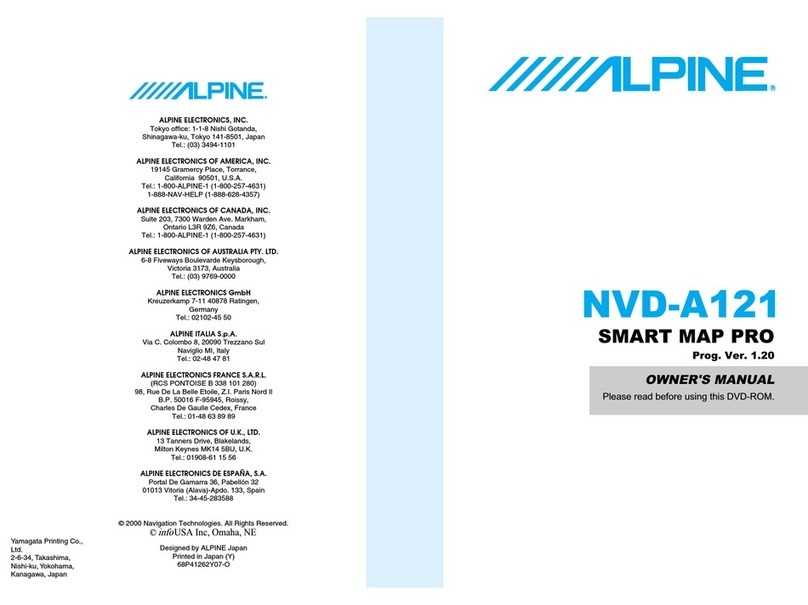
Alpine
Alpine NVD-A121SMART MAP PRO owner's manual

Lowrance
Lowrance AirMap Installation and operation instructions
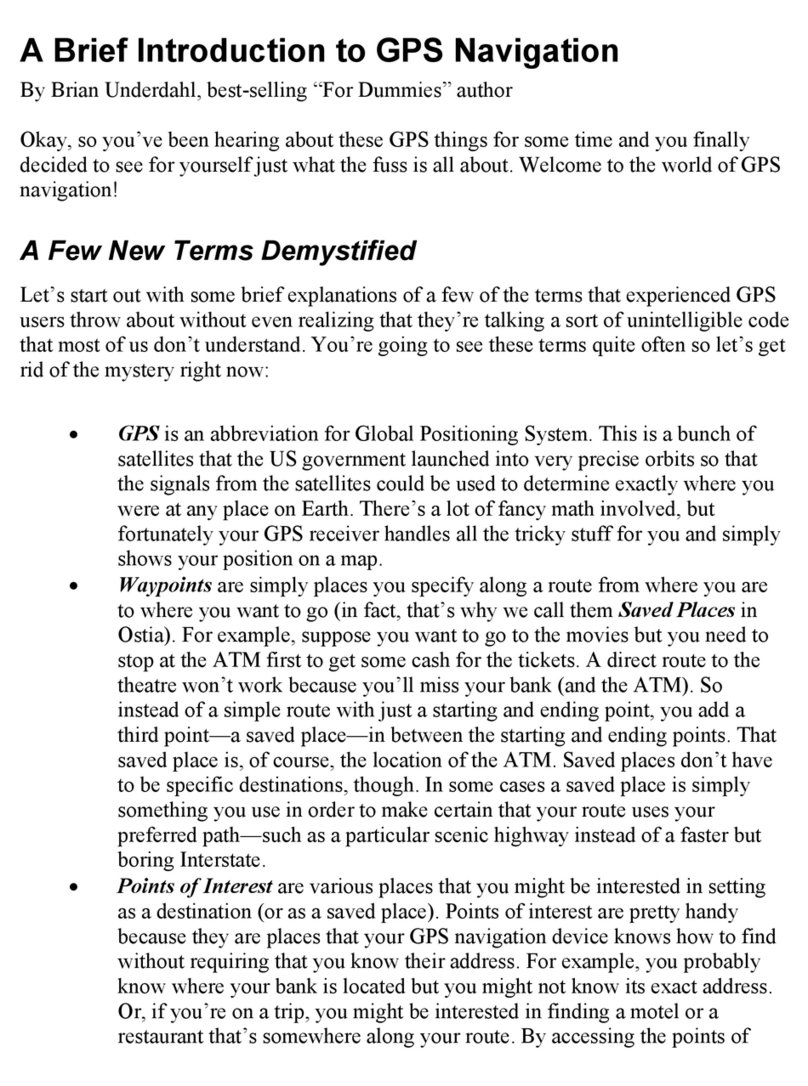
Pharos
Pharos GPS 135 introduction
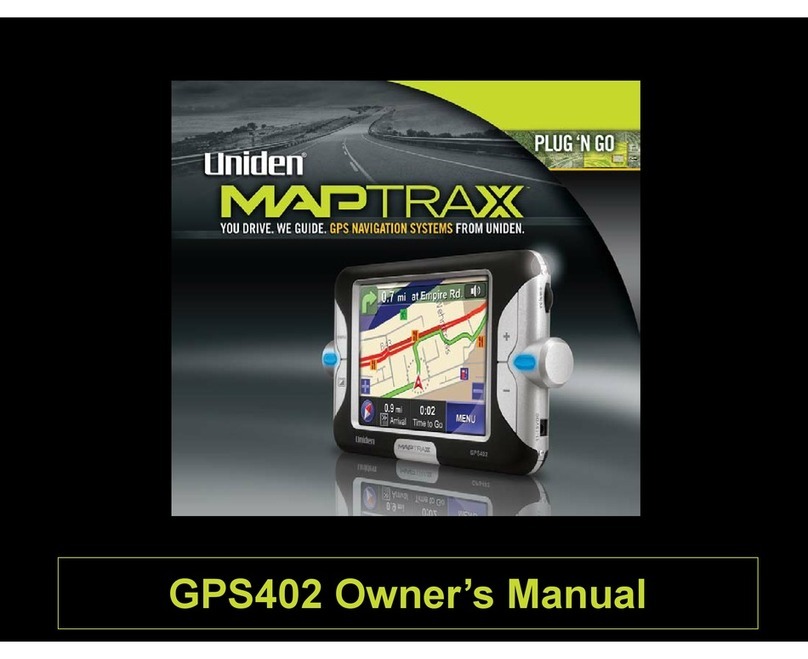
Uniden
Uniden GPS402 - Maptrax - Automotive GPS Receiver owner's manual
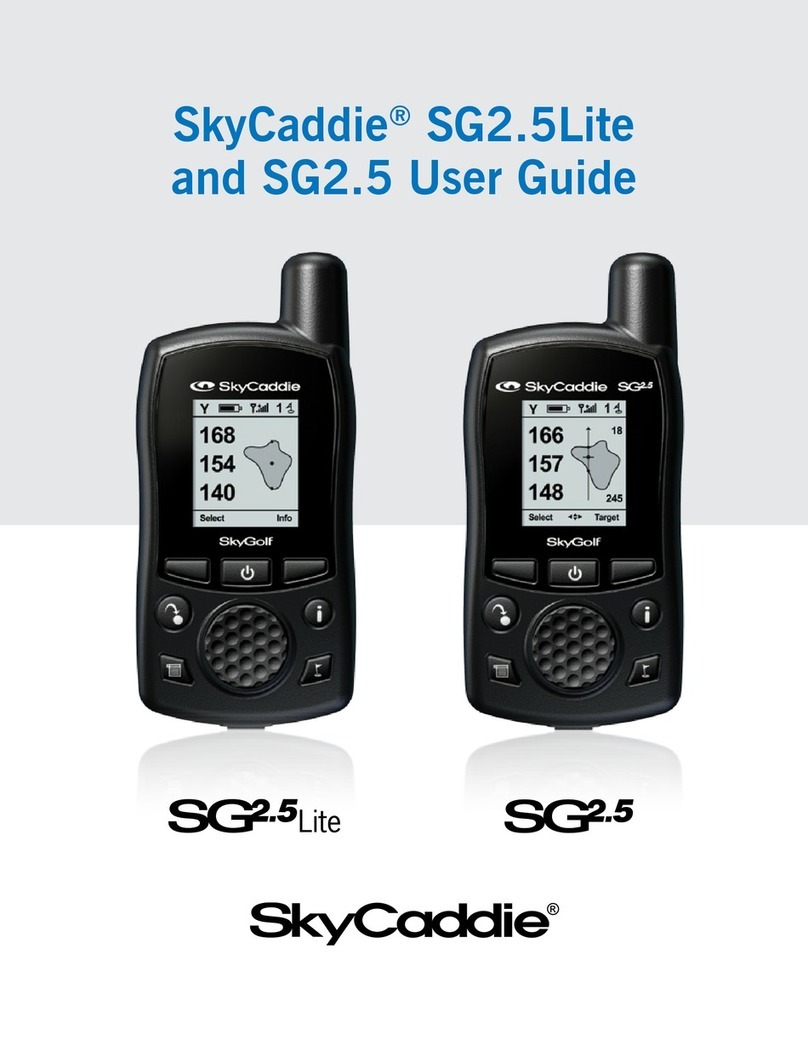
SkyCaddie
SkyCaddie SG2.5Lite user guide




